Fire Regime in Marginal Jack Pine Populations at Their Southern Limit of Distribution, Riding Mountain National Park, Central Canada
Abstract
:1. Introduction
1.1. Fire and Prescribed Fire in Central Canada
1.2. Jack Pine Distribution and Fire Regime
1.3. Fire Regime in the Boreal Plains of Western Manitoba
1.4. Objectives
2. Materials and Methods
2.1. Study Area
2.2. RMNP History
2.3. Field Procedures
2.4. Fire Scar and Chronology Development
2.5. Analyses of Tree-Ring and Climate Data
2.6. Lake Katherine Charcoal Sediment Analyses
3. Results
3.1. Recent Fire History in LKFMU
3.2. Seasonality and Direction of Fires
3.3. Drought and Fire
3.4. Lake Katherine Charcoal Chronology
4. Discussion
4.1. LKFMU Fires: European Exploitation/Settlement Period (1850–1930)
4.2. LKFMU Fires: Fire-Exclusion Period (1930 to the Present)
4.3. LKFMU Fires: Early Period (1450–1850)
4.4. Seasonality and Directional Spread of Fire
4.5. LKFMU Fires, Regional Climatic Influences, and Implications for Management
5. Conclusions
Supplementary Materials
Acknowledgments
Author Contributions
Conflicts of Interest
References
- White, C.A.; Perrakis, D.D.B.; Kafka, V.G.; Ennis, T. Burning at the edge: Integrating biophysical and eco-cultural fire processes in Canada’s parks and protected areas. Fire Ecol. 2011, 7, 74–106. [Google Scholar] [CrossRef]
- Ward, P.C.; Mawdsley, W. Fire management in the boreal forests of Canada. In Fire, Climate Change, and Carbon Cycling in the Boreal Forest; Kasischke, E.S., Stocks, B.J., Eds.; Springer: New York, NY, USA, 2000; pp. 274–288. [Google Scholar]
- Weber, M.G.; Taylor, S.W. The use of prescribed fire in the management of Canada’s forested lands. For. Chron. 1992, 68, 324–334. [Google Scholar] [CrossRef]
- Shay, J.; Kunec, D.; Dyck, B. Short-term effects of fire frequency on vegetation composition and biomass in mixed prairie in south-western Manitoba. Plant Ecol. 2001, 155, 157–167. [Google Scholar] [CrossRef]
- Bleho, B.I.; Koper, N.L.; Borkowsky, C.; Hamel, C.D. Effects of weather and land management on the western prairie fringed-orchid (Platanthera praeclara) at the northern limit of its range in Manitoba, Canada. Am. Midl. Nat. 2015, 174, 191–203. [Google Scholar] [CrossRef]
- Sims, H.P. The effect of prescribed burning on some physical soil properties of jack pine sites in southeastern Manitoba. Can. J. For. Res. 1976, 6, 58–68. [Google Scholar] [CrossRef]
- Weber, M.G.; Stocks, B.J. Forest fires and sustainability in the boreal forests of Canada. Ambio 1998, 27, 545–550. [Google Scholar]
- Parks Canada. Riding Mountain National Park of Canada: Management Plan; Parks Canada: Wasagaming, MB, Canada, 2007.
- Parks Canada. National Fire Management Plan; Parks Canada Agency: Ottawa, ON, Canada, 2008.
- Weir, J.M.H.; Johnson, E.A. Effects of escaped settlement fires and logging on forest composition in the mixedwood boreal forest. Can. J. For. Res. 1998, 28, 459–467. [Google Scholar] [CrossRef]
- Grenier, D.J.; Bergeron, Y.; Kneeshaw, D.; Gauthier, S. Fire frequency for the transitional mixedwood forest of Timiskaming, Québec, Canada. Can. J. For. Res. 2005, 35, 656–666. [Google Scholar] [CrossRef]
- Pellatt, M.G.; Gedalof, Z. Environmental change in Garry oak (Quercus garryana) ecosystems: The evolution of an eco-cultural landscape. Biodivers. Conserv. 2014, 23, 2053–2067. [Google Scholar] [CrossRef]
- Rudolph, T.D.; Laidly, P.R. Pinus banksiana Lamb. jack pine. In Silvics of North America: Volume 1. Conifers; Burns, R.M., Honkala, B.H., Eds.; Forest Service: Washington, DC, USA, 1990; pp. 280–293. [Google Scholar]
- Sims, R.A.; Kershaw, H.M.; Wickware, G.M. The Autecology of Major Tree Species in the North Central Region of Ontario; COFRDA Report 3302; Forestry Canada: Sault Ste. Marie, Ottawa, ON, Canada, 1990.
- Robson, J.R.M.; Conciatori, F.; Tardif, J.C.; Knowles, K. Tree-ring response of jack pine and scots pine to budworm defoliation in central Canada. For. Ecol. Manag. 2015, 347, 83–95. [Google Scholar] [CrossRef]
- Cayford, J.H.; McRae, D.J. The role of fire in jack pine forests. In The Role of Fire in Northern Circumpolar Ecosystems; Wein, R.W., MacLean, D.A., Eds.; John Wiley & Sons: New York, NY, USA, 1983; pp. 183–199. [Google Scholar]
- Gauthier, S.; Bergeron, Y.; Simon, J.P. Effects of fire regime on the serotiny level of jack pine. J. Ecol. 1996, 84, 539–548. [Google Scholar] [CrossRef]
- Simard, A.J.; Blank, R.W. Fire history of a Michigan jack pine forest. Mich. Acad. 1982, 15, 59–71. [Google Scholar]
- Desponts, M.; Payette, S. Recent dynamics of jack pine and its northern distribution limit in northern Québec. Can. J. Bot. 1992, 70, 1157–1167. [Google Scholar] [CrossRef]
- Bailey, R.H. Notes on the Vegetation in Riding Mountain National Park Manitoba; National Parks Forest Survey No. 2.; Department of Forestry and Rural Development, Forest Management Institute: Ottawa, ON, Canada, 1968.
- Abrams, M.D. Uneven-aged jack pine in Michigan. J. For. 1984, 82, 306–307. [Google Scholar]
- Conkey, L.E.; Keifer, M.; Lloyd, A.H. Disjunct jack pine (Pinus banksiana Lamb.) structure and dynamics, Acadia National Park, Maine. Écoscience 1995, 2, 168–176. [Google Scholar]
- Bergeron, Y.; Brisson, J. Fire regime in red pine stands at the northern limit of the species’ range. Ecology 1990, 71, 1352–1364. [Google Scholar] [CrossRef]
- Grotte, K.L.; Heinricks, D.K.; Tardif, J.C. Old-growth characteristics of disjunct Thuja occidentalis stands at their northwestern distribution limit, central Canada. Nat. Areas J. 2012, 32, 270–282. [Google Scholar] [CrossRef]
- Tardif, J. Fire History in the Duck Mountain Provincial Forest, Western Manitoba. Sustainable Forest Management Network; University of Alberta: Edmonton, AB, Canada, 2004. [Google Scholar]
- Weir, J.M.H.; Johnson, E.A.; Miyanishi, K. Fire frequency and the spatial age mosaic of the mixed-wood boreal forest in western Canada. Ecol. Appl. 2000, 10, 1162–1177. [Google Scholar] [CrossRef]
- Harrison, J.D.B. The Forests of Manitoba; Forest Service Bulletin 85; Department of the Interior: Ottawa, ON, Canada, 1934.
- Stevenson, H.I. The Forests of Manitoba; Report No. 9; Manitoba Economic Survey Board: Winnipeg, MB, Canada, 1938. [Google Scholar]
- Gill, C.B. Cyclic forest phenomena. For. Chron. 1930, 6, 42–56. [Google Scholar] [CrossRef]
- Barlow, J.L. Riding Mountain National Park Resource Description and Analysis; Natural Resource Conservation Prairie Region, Parks Canada: Ottawa, ON, Canada, 1979.
- Caners, R.T.; Kenkel, N.C. Forest stand structure and dynamics at Riding Mountain National Park, Manitoba, Canada. Community Ecol. 2003, 4, 185–204. [Google Scholar] [CrossRef]
- Canadian Parks and Wilderness Society (CPAWS). Riding Mountain Ecosystem Community Atlas; Canadian Parks and Wilderness Society (CPAWS): Winnipeg, MB, Canada, 2004. [Google Scholar]
- Rowe, J.S. Factors Influencing White Spruce Reproduction in Manitoba and Saskatchewan; Forestry Branch Tech. Note No. 3; Department of Northern Affairs and National Resources: Ottawa, ON, Canada, 1955.
- Sentar Consultants Ltd. Riding Mountain National Park: A Literature Review of Historic Timber Harvesting and Forest Fire Activity; Parks Canada: Wasagaming, MB, Canada, 1992.
- Dickson, J.R. The Riding Mountain Forest Reserve; Forestry Branch Bull. No. 6; Department of the Interior: Ottawa, ON, Canada, 1909.
- Cornelsen, S.; Vanderschuit, W. Riding Mountain National Park Fire Management Plan; Unpublished Report; Parks Canada: Wasagaming, MB, Canada, 2002.
- Tunstell, G.; Gill, C.B.; Kuhring, G.F. Silvical Report on Riding and Duck Mountain Forest Reserves; Unpublished Department of Interior Report; Canada Forest Service: Ottawa, ON, Canada, 1922.
- Parks Canada. Parks Canada Policy; Publication QS-7079-000-EE-A1; Parks Canada: Ottawa, ON, Canada, 1979.
- Rowe, J.S. Forest Regions of Canada; Publication No. 1300; Department of Environment, Canadian Forest Service: Ottawa, ON, Canada, 1972.
- RSmith, E.; Veldhuis, H.; Mills, G.F.; Eilers, R.G.; Fraser, W.R.; Lelyk, G.W. Terrestrial Ecozones, Ecoregions, and Ecodistricts, an Ecological Stratification of Manitoba’s Landscapes; Technical Bulletin 98-9E; Land Resource Unit, Brandon Research Centre, Research Branch, Agriculture and Agri-Food Canada: Winnipeg, MB, Canada, 1998.
- Ritchie, J.C. Absolute pollen frequencies and carbon-14 age of a section of Holocene lake sediment from the Riding Mountain area of Manitoba. Can. J. Bot. 1969, 47, 1345–1349. [Google Scholar] [CrossRef]
- Zoltai, S. Southern Limit of Coniferous Trees on the Canadian Prairies; Information Report NOR-X-128; Environment Canada, Forestry Service, Northern Forest Research Center: Edmonton, AB, Canada, 1975.
- Environment Canada. Canadian Climate Normals and Averages 1981–2010; National Climate Archives; Meteorological Service of Canada, Environment Canada: Toronto, ON, Canada, 2016. Available online: http://climate.weatheroffice.ec.gc.ca/climate_normals/index_e.html (accessed on 24 June 2016).
- Tabulenas, D.T. A Narrative Human History of Riding Mountain National Park and Area: Prehistory to 1980; Parks Canada: Wasagaming, MB, Canada, 1983.
- Nicholson, B.A. Human Ecology and Prehistory of the Forest/Grassland Transition Zone of Western Manitoba. Ph.D. Thesis, Department of Archaeology, Simon Fraser University, Vancouver, BC, Canada, 1987. [Google Scholar]
- Peckett, M.K. Anishnabe Homeland History: Traditional Land and Resources Use of Riding Mountain, Manitoba. Master’s Thesis, University of Manitoba, Winnipeg, MB, Canada, 1999. [Google Scholar]
- Sandlos, J. Not wanted in the boundary: The expulsion of the Keeseekoowenin Ojibway band from Riding Mountain National Park. Can. Hist. Rev. 2008, 89, 189–221. [Google Scholar] [CrossRef]
- Arno, S.F.; Sneck, K.M. A method for Determining Fire History in Coniferous Forests in the Mountain West; General Technical Report INT-42; U.S.D.A. Forest Service, Inter Mountain Forest and Range Experimental Station: Fort Collins, CO, USA, 1977.
- McBride, J.R. Analysis of tree rings and fire scars to establish fire history. Tree-Ring Bull. 1983, 43, 51–67. [Google Scholar]
- Johnson, E.A.; Gutsell, S.L. Fire frequency models, methods, and interpretations. Adv. Ecol. Res. 1994, 25, 239–287. [Google Scholar]
- Gutsell, S.L.; Johnson, E.A. How fire scars are formed: Coupling a disturbance process to its ecological effect. Can. J. For. Res. 1996, 26, 166–174. [Google Scholar] [CrossRef]
- Falk, D.A.; Heyerdahl, E.K.; Brown, P.M.; Farris, C.; Fulé, P.Z.; McKenzie, D.; Swetnam, T.W.; Taylor, A.H.; van Horne, M.L. Multi-scale controls of historical forest-fire regimes: New insights from fire-scar networks. Front. Ecol. Environ. 2011, 9, 446–454. [Google Scholar] [CrossRef]
- Tardif, J.C.; Girardin, M.P.; Conciatori, F. Light rings as bioindicators of climate change in Interior North America. Glob. Planet. Chang. 2011, 79, 134–144. [Google Scholar] [CrossRef]
- Madany, M.H.; Swetnam, T.W.; West, N.E. Comparison of two approaches for determining fire dates from tree scars. For. Sci. 1982, 28, 856–861. [Google Scholar]
- Baisan, C.H.; Swetnam, T.W. Fire history of a desert mountain range: Rincon Mountain wilderness, Arizona, U.S.A. Can. J. For. Res. 1990, 20, 1559–1569. [Google Scholar] [CrossRef]
- Waito, J.; Conciatori, F.; Tardif, J.C. Frost rings and white earlywood rings in Picea mariana trees from the boreal plains, central Canada. IAWA J. 2013, 34, 71–87. [Google Scholar] [CrossRef]
- Holmes, R.L. Computer-assisted quality control in tree-ring dating and measurement. Tree-Ring Bull. 1983, 43, 69–78. [Google Scholar]
- Cook, E.R. A Time Series Approach to Tree-Ring Standardization. Ph.D. Thesis, University of Arizona, Tucson, AZ, USA, 1985. [Google Scholar]
- Brewer, P.W.; Velásquez, M.E.; Sutherland, E.K.; Falk, D.A. Fire History Analysis and Exploration System (FHAES), version 2.0.1; Available online: http://www.fhaes.org (accessed on 2 May 2016). [CrossRef]
- Grissino-Mayer, H.D. FHX2- Software for analyzing temporal and spatial patterns in fire regimes from tree rings. Tree-Ring Res. 2001, 57, 115–124. [Google Scholar]
- Grissino-Mayer, H.D. Modeling fire interval data from the American southwest with the Weibull distribution. Int. J. Willdland Fire 1999, 9, 37–50. [Google Scholar] [CrossRef]
- Lombardo, K.J.; Swetnam, T.W.; Baisan, C.H.; Borchert, M.I. Using bigcone Douglas-fir fire scars and tree rings to reconstruct interior chaparral fire history. Fire Ecol. 2009, 5, 35–56. [Google Scholar] [CrossRef]
- Girardin, M.P.; Tardif, J.C.; Flannigan, M.; Bergeron, Y. Synoptic-scale atmospheric circulation and boreal Canada summer drought variability of the past three centuries. J. Clim. 2006, 19, 1922–1947. [Google Scholar] [CrossRef]
- Kooyman, A.H. The Aquatic Resources of Riding Mountain National Park. Volume III: Data on Lakes; Canadian Wildlife Services: Winnipeg, MB, Canada, 1980. [Google Scholar]
- Glew, J. A portable extruding device for close interval sectioning of unconsolidated core samples. J. Paleolimnol. 1988, 1, 235–239. [Google Scholar] [CrossRef]
- Brossier, B.; Oris, F.; Finsinger, W.; Asselin, H.; Bergeron, Y.; Ali, A.A. Using tree-ring records to calibrate peak detection in fire reconstructions based on sedimentary charcoal records. Holocene 2014, 24, 635–645. [Google Scholar] [CrossRef]
- PHiguera, E.; Whitlock, C.; Gage, J.A. Linking tree-ring and sediment-charcoal records to reconstruct fire occurrence and area burned in subalpine forests of Yellowstone National Park, USA. Holocene 2010, 21, 327–341. [Google Scholar] [CrossRef]
- Wright, H.E.; Mann, D.H.; Glaser, P.H. Piston corers for peat and lake sediments. Ecology 1984, 65, 657–659. [Google Scholar] [CrossRef]
- Björk, S.; Wohlfarth, B. 14C Chronostratigraphic techniques in paleolimnology. In Tracking Environmental Change Using Lake Sediments Volume 1: Basin Analysis, Coring and Chronological Techniques; Last, W.M., Smol, J.P., Eds.; Kluwer Academic Publishers: Dordrecht, The Netherlands, 2001; pp. 205–245. [Google Scholar]
- Stuiver, M.; Reimer, P.J. Extended (super 14) C data base and revised CALIB 3.0 (super 14) C age calibration program. Radiocarbon 1993, 35, 215–230. [Google Scholar] [CrossRef]
- Reimer, P.J.; Bard, E.; Bayliss, A.; Beck, J.W.; Blackwell, P.G.; Ramsey, C.B.; Buck, C.E.; Cheng, H.; Edwards, R.L.; Friedrich, M.; et al. Intcal13 and marine13 radiocarbon age calibration curves 0–50,000 years cal BP. Radiocarbon 2013, 55, 1869–1887. [Google Scholar] [CrossRef] [Green Version]
- Higuera, P.E. MCAgeDepth 0.1: Probabilistic Age-Depth Models for Continuous Sediment Records. User’s Guide; Montana State University: Bozeman, MT, USA, 2008. [Google Scholar]
- Schlachter, K.J.; Horn, S.P. Sample preparation methods and replicability in macroscopic charcoal analysis. J. Paleolimnol. 2009, 44, 701–708. [Google Scholar] [CrossRef]
- Jensen, K.; Lynch, E.A.; Calcote, R.; Hotchkiss, S.C. Interpretation of charcoal morphotypes in sediments from Ferry Lake, Wisconsin, USA: Do different plant fuel sources produce distinctive charcoal morphotypes? Holocene 2007, 17, 907–915. [Google Scholar] [CrossRef]
- Higuera, P.E. CharAnalysis 0.9: Diagnostic and Analytical Tools for Sediment Charcoal Analysis: User’s Guide; Montana State University: Bozeman, MT, USA, 2009. [Google Scholar]
- Higuera, P.E.; Gavin, D.G.; Bartlein, P.J.; Hallett, D.J. Peak detection in sediment-charcoal records: Impacts of alternative data analysis methods on fire-history interpretations. Int. J. Wildland Fire 2010, 19, 996–1014. [Google Scholar] [CrossRef]
- Kelly, R.F.; Higuera, P.E.; Barrett, C.M.; Hu, F.S. A signal-to-noise index to quantify the potential for peak detection in sedimentcharcoal records. Quat. Res. 2011, 75, 11–17. [Google Scholar] [CrossRef]
- Van Wagner, C.E. Development and Structure of the Canadian Forest Fire Weather Index System; Forestry Technical Report 35; Canadian Forestry Servive: Ottawa, ON, Canada, 1987.
- Stambaugh, M.C.; Guyette, R.P.; Godfrey, R.; McMurry, E.R.; Marschall, J.M. Fire, drought, and human history near the western terminus of the Cross Timbers, Wichita Mountains, Oklahoma, USA. Fire Ecol. 2009, 52, 51–65. [Google Scholar] [CrossRef]
- Rannie, W.F. Awful splendour: Historical accounts of prairie fire in southern Manitoba prior to 1870. Prairie Forum 2001, 26, 17–45. [Google Scholar]
- Heinselman, M.L. Fire in the virgin forests of the Boundary Waters Canoe Area, Minnesota. Quat. Res. 1973, 3, 329–382. [Google Scholar] [CrossRef]
- Heinselman, M.L. Fire intensity and frequency as factors in the distribution and structure of northern ecosystems. In Proceedings of the Conference Fire Regimes and Ecosystem Properties, Honolulu, HI, USA, 11–15 December 1981.
- Lynham, T.J.; Stocks, B.J. The natural fire regime of an unprotected section of the boreal forest in Canada. In High Intensity Fire in Wildlands: Management Challenges and Options, Proceedings of the 17th Tall Timbers Fire Ecology Conference, Tallahassee, FL, USA, 18–21 May 1989.
- Larsen, C.P.S.; MacDonald, G.M. Fire and vegetation dynamics in a jack pine and black spruce forest reconstructed using fossil pollen and charcoal. J. Ecol. 1998, 86, 815–828. [Google Scholar] [CrossRef]
- Cleland, D.T.; Crow, T.R.; Saunders, S.C.; Dickmann, D.I.; Maclean, A.L.; Jordan, J.K.; Watson, R.L.; Sloan, A.M.; Brosofske, K.D. Characterizing historical and modern fire regimes in Michigan (USA): A landscape ecosystem approach. Landsc. Ecol. 2004, 19, 311–325. [Google Scholar] [CrossRef]
- Lefort, P.; Gauthier, S.; Bergeron, Y. The influence of fire weather and land use on the fire activity of the Lake Abitibi area, eastern Canada. For. Sci. 2003, 49, 509–521. [Google Scholar]
- Pyne, S.J. Awful Splendour: A Fire History of Canada; UBC Press: Vancouver, BC, Canada, 2008. [Google Scholar]
- Boyd, M. Identification of anthropogenic burning in the paleoecological record of the northern prairies: A new approach. Ann. Assoc. Am. Geogr. 2002, 92, 471–487. [Google Scholar] [CrossRef]
- Burrows, W.R.; King, P.; Lewis, P.J.; Kochtubajda, B.; Snyder, B.; Turcotte, V. Lightning occurrence patterns over Canada and adjacent United States from lighning detection network observations. Atmos. Ocean 2002, 40, 59–81. [Google Scholar] [CrossRef]
- Roy-Denis, C. Fire for well-being: Use of prescribed burning in the northern boreal forest. Earth Common J. 2015, 5, 40–50. [Google Scholar]
- Lewis, H.T. A Time for Burning, Edmonton: Boreal Institute for Northern Studies; University of Alberta: Edmonton, AB, Canada, 1982. [Google Scholar]
- Lutz, H.J. Aboriginal Man and White Man as Historical Causes of Fires in the Boreal Forest, with Particular Reference to Alaska; School of Forestry Bulletin No 65; Yale University: New Haven, CT, USA, 1959. [Google Scholar]
- Ferguson, T.A. “Careless fires” and “smoaky weather”: The documentation of prescribed burning in the Peace–Athabasca trading post journals 1818–1899. For. Chron. 2011, 87, 414–419. [Google Scholar] [CrossRef]
- Miller, A.M. Living with Boreal Forest Fires: Anishinaabe Perspectives on Disturbance and Collaborative Forestry Planning, Pikangikum First Nation, Northwestern Ontario. Ph.D. Thesis, Natural Resource and Environmental Management, University of Manitoba, Winnipeg, MB, Canada, 2010. [Google Scholar]
- Raven, G.; Hollow Water First Nation, Lake Winnipeg, MB, Canada. Personal communication, 2004.
- Johnson, E.A.; Miyanishi, K.; O’Brien, N. Long-term reconstruction of the fire season in the mixedwood boreal forest of Western Canada. Can. J. Bot. 1999, 77, 1185–1188. [Google Scholar] [CrossRef]
- Heinrichs, D.K.; Tardif, J.C.; Bergeron, Y. Xylem production in six tree species growing on an island in the boreal forest region of western Québec, Canada. Can. J. Bot. 2007, 85, 518–525. [Google Scholar] [CrossRef]
- George, S.S.; Nielsen, E. Palaeoflood records for the Red River, Manitoba, Canada derived from anatomical tree-ring signatures. Holocene 2003, 13, 547–555. [Google Scholar] [CrossRef]
- Hill, R.B. Manitoba: History of Its Early Settlement, Development and Resources; William Briggs: Toronto, ON, Canada, 1890. [Google Scholar]
- Sauchyn, D.J.; Skinner, W.R. A proxy record of drought severity for the southwestern Canadian plains. Can. Water Res. 2001, 26, 253–272. [Google Scholar] [CrossRef]
- George, S.S.; Meko, D.M.; Girardin, M.P.; Macdonald, G.M.; Nielsen, E.; Pederson, G.T.; Sauchyn, D.J.; Tardif, J.C.; Watson, E. The tree-ring record of drought on the Canadian prairies. J. Clim. 2009, 22, 689–710. [Google Scholar] [CrossRef]
- Johnson, E.A.; Miyanishi, K.; Weir, J.M.H. Wildfires in the western Canadian boreal forest: Landscape patterns and ecosystem management. J. Veg. Sci. 1998, 9, 603–610. [Google Scholar] [CrossRef]
- Corson, C.W.; Allison, J.H.; Cheyney, E.G. Factors controlling forest types on the Cloquet forest, Minnesota. Ecology 1929, 10, 112–125. [Google Scholar] [CrossRef]
- Fritz, R.; Suffling, R.; Younger, T.A. Influence of fur trade, famine and forest fires on moose and woodland caribou populations in northwestern Ontario from 1786 to 1911. Environ. Manag. 1993, 17, 477–489. [Google Scholar] [CrossRef]
- Cwynar, L.C. The recent fire history of Barron Township, Algonquin Park. Can. J. Bot. 1977, 55, 1524–1538. [Google Scholar] [CrossRef]
- Burgess, D.M.; Methven, I.R. The Historical Interaction of Fire, Logging and Pine: A Case Study at Chalk River, Ontario; Information Report PS-X-66; Canadian Forestry Service, Petawawa Forest Experiment Station: Chalk River, ON, Canada, 1977.
- Keane, R.E.; Ryan, K.C.; Veblen, T.T.; Allen, C.D.; Logan, J.; Hawkes, B. Cascading Effects of Fire Exclusion in the Rocky Mountain Ecosystems: A Literature Review; General Technical Report RMRSGTR-91; U.S. Department of Agriculture: Fort Collins, CO, USA, 2002.
- Fulé, P.Z. Does it make sense to restore wildland fire in changing climate? Restor. Ecol. 2008, 16, 526–531. [Google Scholar] [CrossRef]
- Gaulhier, S.; Bergeron, Y.; Simon, J.P. Cone serotiny in jack pine: Ontogenetic, positional, and environmental effects. Can. J. For. Res. 1993, 23, 394–401. [Google Scholar]
- Girardin, M.P.; Ali, A.A.; Carcaillet, C.; Gauthier, S.; Hély, C.; le Goff, H.; Terrier, A.; Bergeron, Y. Fire in managed forests of eastern Canada: Risks and options. For. Ecol. Manag. 2012, 294, 238–249. [Google Scholar] [CrossRef]
- Wotton, B.M.; Nock, C.A.; Flannigan, M.D. Forest fire occurrence and climate change in Canada. Int. J. Wildland Fire 2010, 19, 253–271. [Google Scholar] [CrossRef]
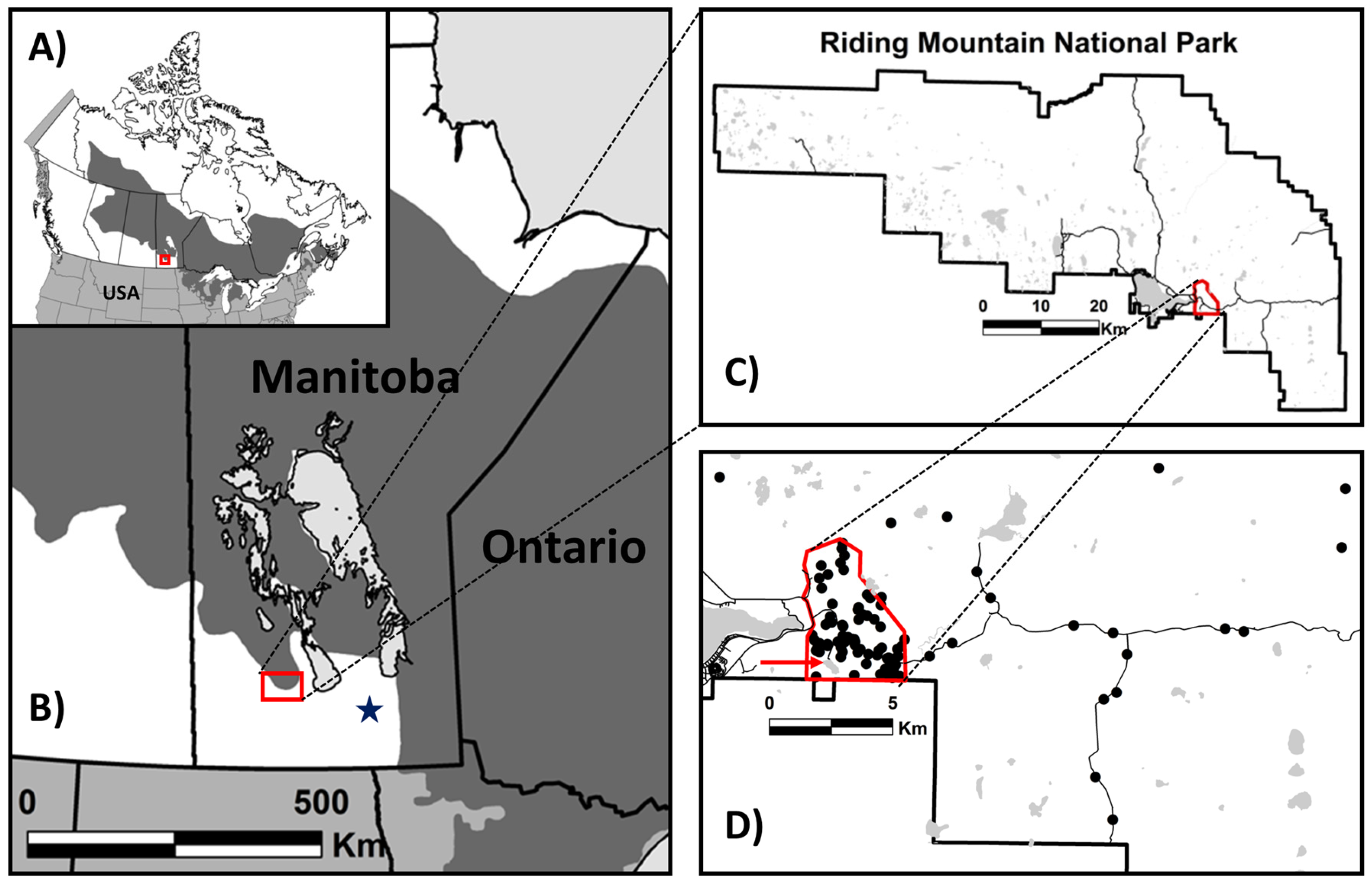
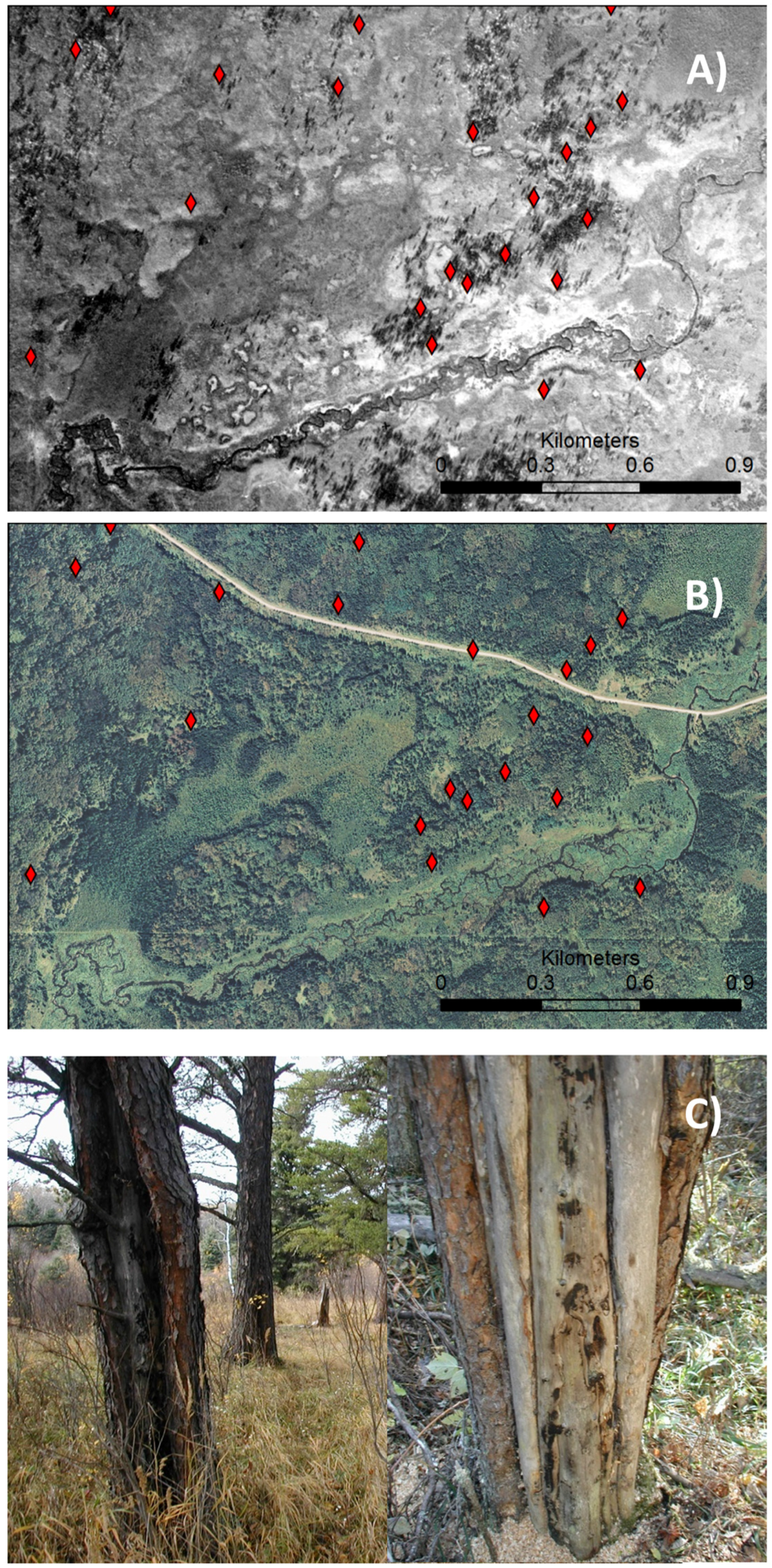
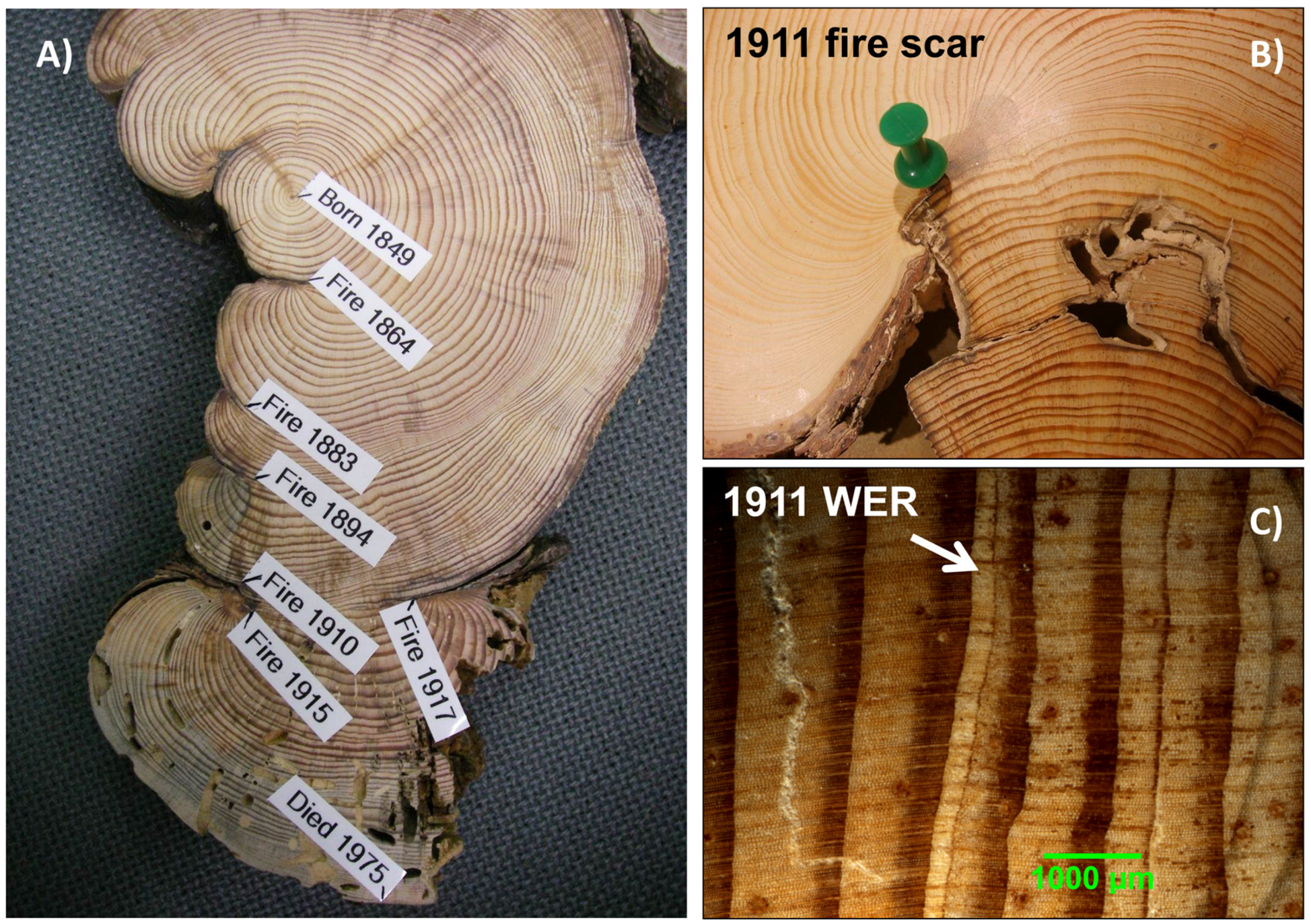
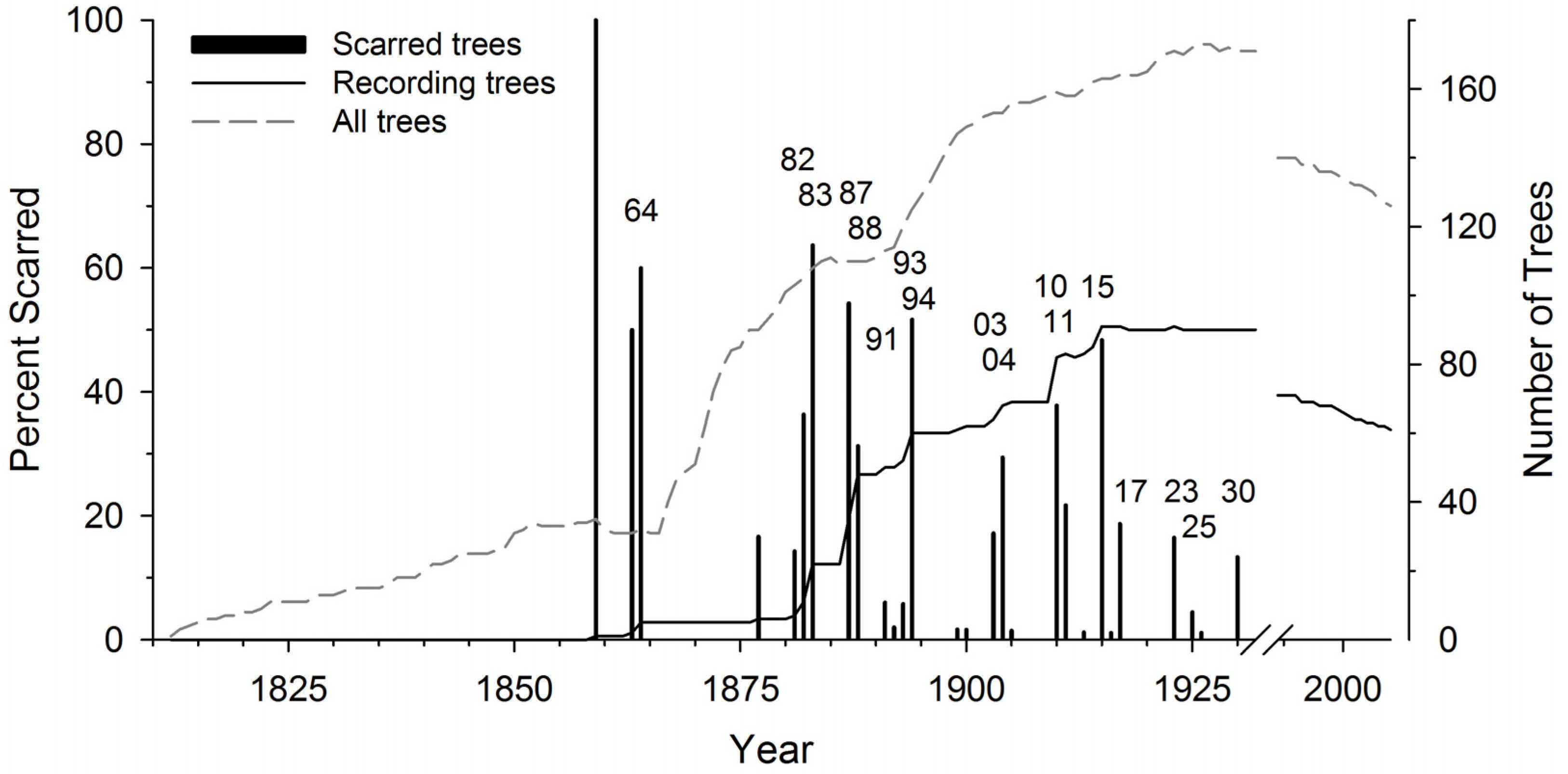

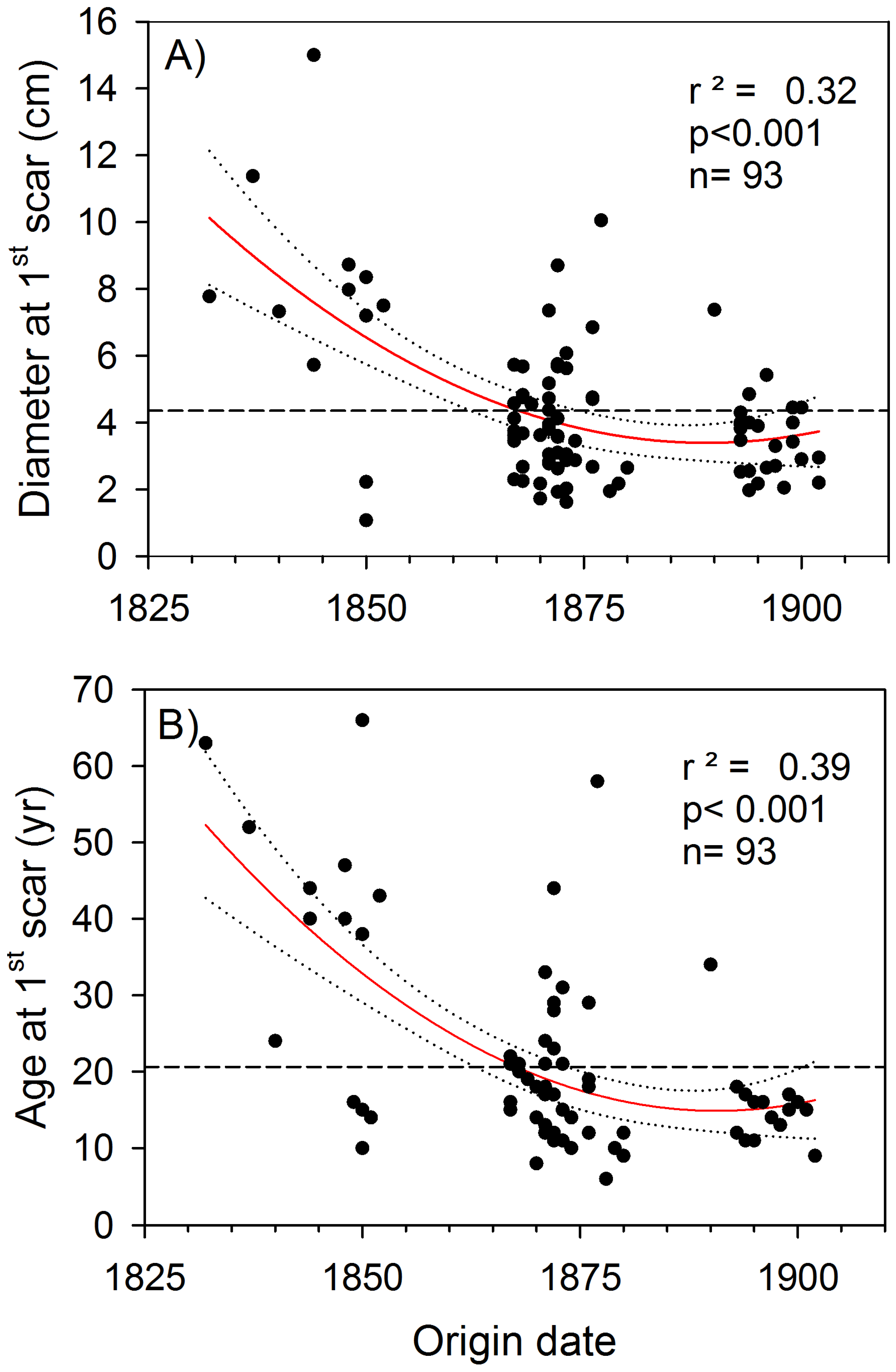


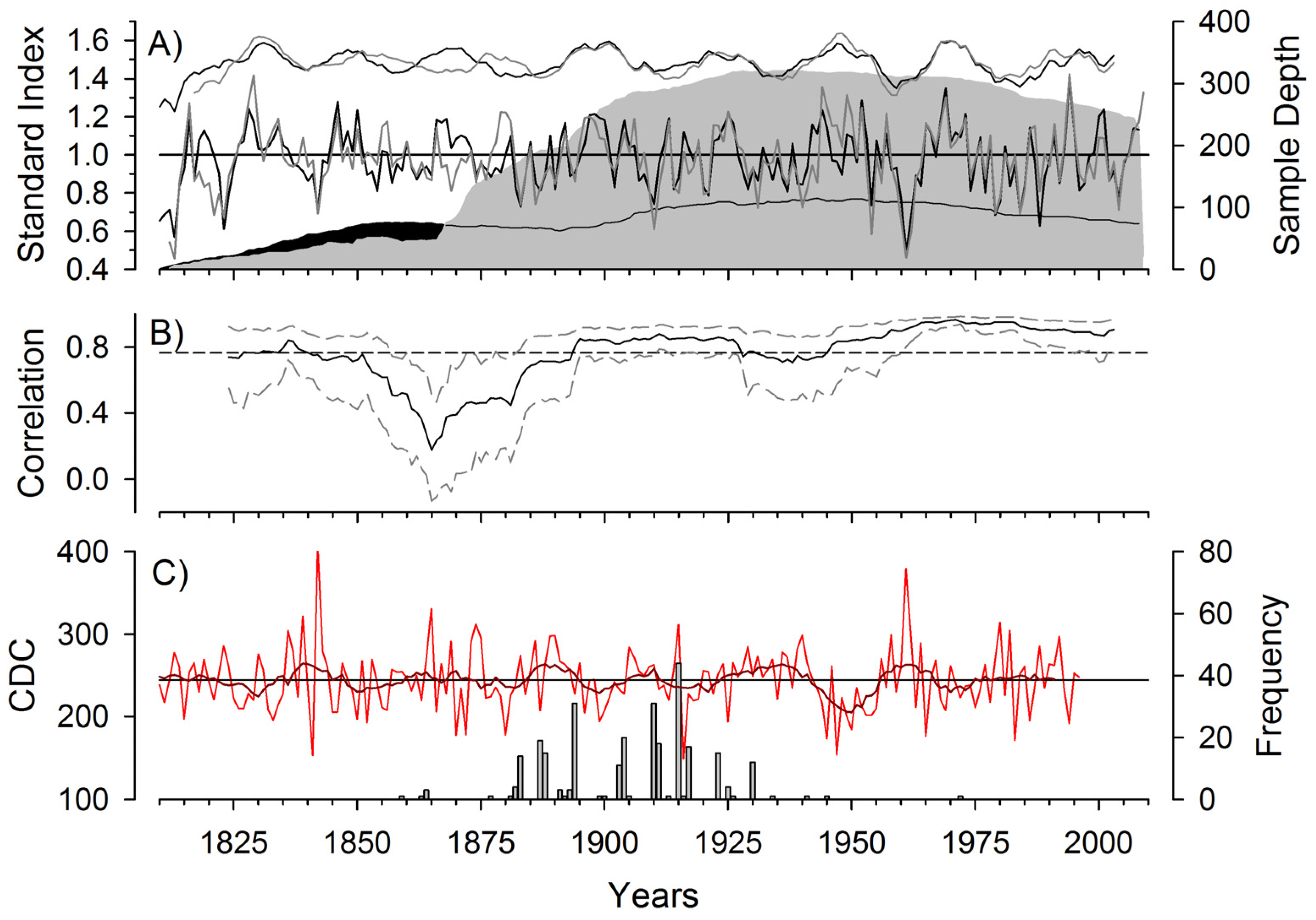
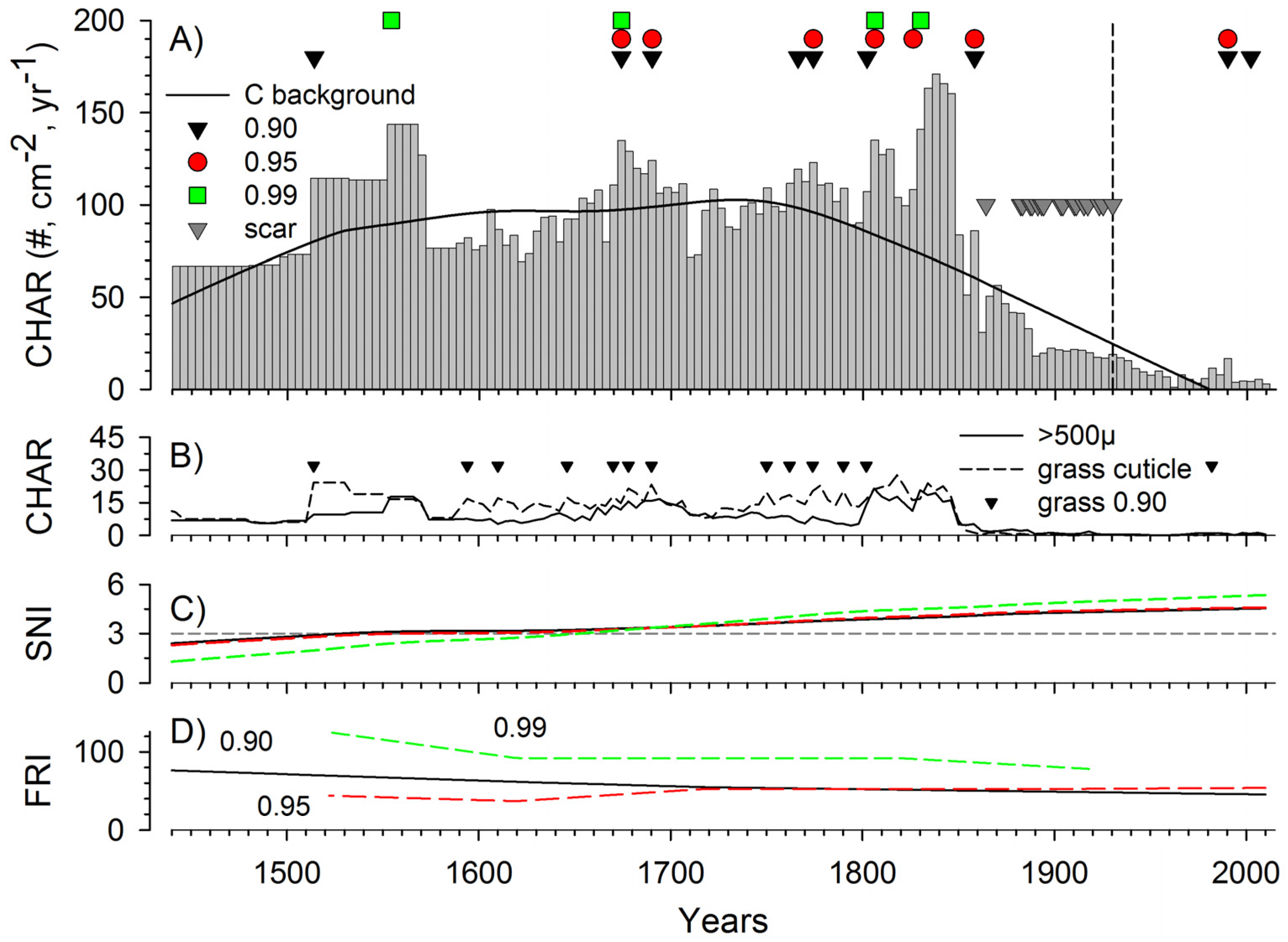
| LKFMU | LKFMU | LKFMU | LKFMU | |
|---|---|---|---|---|
| All Sampled Trees | Composite: 1% Recording Trees Scarred | Composite: 10% Recording Trees Scarred | Composite: 25% Recording Trees Scarred | |
| Year of coverage | 1850–1930 | 1850–1930 | 1850–1930 | 1850–1930 |
| Minimum number of sample | 1 | 1 | 1 | 1 |
| Total intervals | 181 | 27 | 17 | 10 |
| Mean fire interval | 10.98 | 2.63 | 4.18 | 5.60 |
| Median fire interval | 10.00 | 1.00 | 4.00 | 4.50 |
| Fire frequency | 0.09 | 0.38 | 0.24 | 0.18 |
| Weibull mean interval | 11.03 | 2.66 | 4.19 | 5.62 |
| Weibull median interval | 10.19 | 2.10 | 3.42 | 4.36 |
| Weibull fire frequency | 0.10 | 0.48 | 0.29 | 0.23 |
| Minimum fire interval | 1 | 1.00 | 1.00 | 1.00 |
| Maximum fire interval | 38 | 13.00 | 13.00 | 18.00 |
| Lower exceedance interval | 4.19 | 0.55 | 0.96 | 1.08 |
| Upper exceedance interval | 18.44 | 5.17 | 7.98 | 11.05 |
| Including WER | ||||
| Total intervals | 189 | No Change | No Change | No Change |
| Mean fire interval | 10.75 | No Change | No Change | No Change |
| Median fire interval | 10.00 | No Change | No Change | No Change |
| Fire frequency | 0.09 | No Change | No Change | No Change |
| Weibull mean interval | 10.79 | No Change | No Change | No Change |
| Weibull median interval | 9.96 | No Change | No Change | No Change |
| Weibull fire frequency | 0.10 | No Change | No Change | No Change |
| Minimum fire interval | 1 | No Change | No Change | No Change |
| Maximum fire interval | 38 | No Change | No Change | No Change |
| Lower exceedance interval | 4.08 | No Change | No Change | No Change |
| Upper exceedance interval | 18.05 | No Change | No Change | No Change |
| Number | % | |
|---|---|---|
| Total fire scars | 279 | 100 |
| Scars with season determined | 269 | 96.4 |
| Scars undetermined | 10 | 3.6 |
| Dormant (D) | 214 | 79.6 |
| First third earlywood (E) | 39 | 14.5 |
| Second third earlywood (M) | 16 | 5.9 |
| Last third earlywood (L) | 0 | 0.0 |
| Latewood (A) | 0 | 0.0 |
| DEM | 269 | 100.0 |
| LA | 0 | 0.0 |
© 2016 by the authors; licensee MDPI, Basel, Switzerland. This article is an open access article distributed under the terms and conditions of the Creative Commons Attribution (CC-BY) license (http://creativecommons.org/licenses/by/4.0/).
Share and Cite
Tardif, J.C.; Cornelsen, S.; Conciatori, F.; Hodgin, E.B.; Pellatt, M.G. Fire Regime in Marginal Jack Pine Populations at Their Southern Limit of Distribution, Riding Mountain National Park, Central Canada. Forests 2016, 7, 219. https://doi.org/10.3390/f7100219
Tardif JC, Cornelsen S, Conciatori F, Hodgin EB, Pellatt MG. Fire Regime in Marginal Jack Pine Populations at Their Southern Limit of Distribution, Riding Mountain National Park, Central Canada. Forests. 2016; 7(10):219. https://doi.org/10.3390/f7100219
Chicago/Turabian StyleTardif, Jacques C., Stephen Cornelsen, France Conciatori, Eben Blake Hodgin, and Marlow G. Pellatt. 2016. "Fire Regime in Marginal Jack Pine Populations at Their Southern Limit of Distribution, Riding Mountain National Park, Central Canada" Forests 7, no. 10: 219. https://doi.org/10.3390/f7100219






